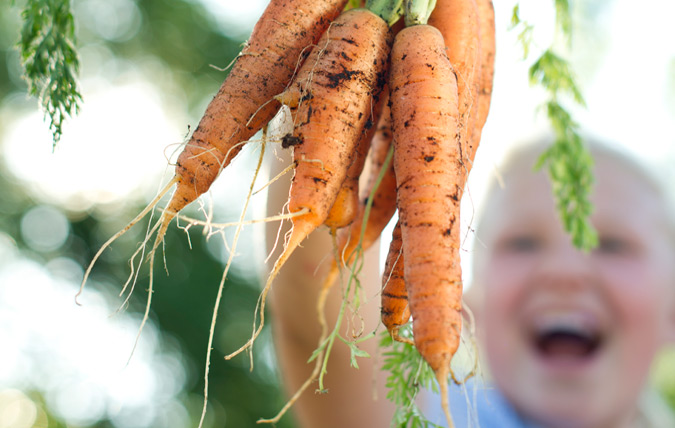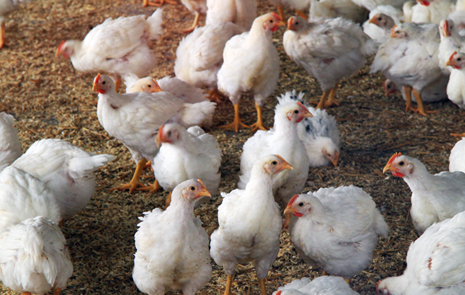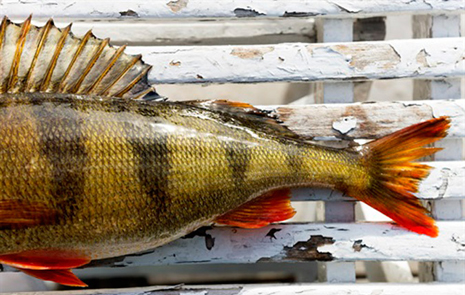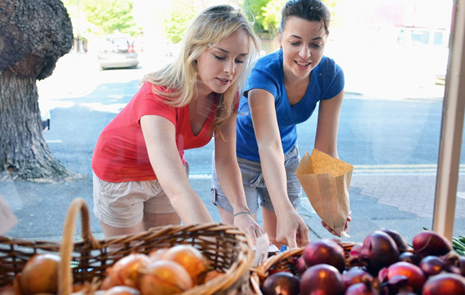Fruit, berries and vegetables

The environmental impact of fruits, berries, vegetables and legumes varies greatly depending on how and where they are grown and how delicate they are.
Fruit and vegetables contain fibre, vitamins and other important substances. Coarse vegetables and legumes, such as beans and lentils, are particularly valuable because of their nutrient content.
The environmental impact of fruits, berries, vegetables and legumes varies greatly depending on how and where they are grown and how delicate they are. Coarse, hardy vegetables – like root vegetables, cabbage, cauliflower and onion – are often grown on open land and therefore affect the climate less than vegetables that are cultivated in greenhouses. Coarse vegetables can also be stored for longer than more delicate vegetables such as tomato, lettuce and cucumber.
Fruits and vegetables that have been produced with little or no pesticides, such as organic alternatives, contribute to a non-toxic environment.
Longer shipping distances often result in more greenhouse gas emissions than shorter ones, but the mode of transport is also significant. It is therefore good for the environment when fruits and vegetables are transported efficiently.
Did you know...
...that sensitive fruits and vegetables that spoil quickly, like berries and fresh legumes, are often transported by air if they are shipped long distances? This has a very large impact on the climate.
...that fruit and vegetables are the types of food we throw away most? We can reduce wastage by storing them correctly so that they keep longer and by not buying more than we can use.
...that beans, lentils and peas have a relatively low environmental impact – especially when they replace meat?
Effect on the climate
In the case of fruit and vegetables, the emission of greenhouse gases comes mainly from transportation, the cultivation itself and from the use of fertilisers.
Transportation can account for a large part of the greenhouse gas emissions. How much is generated depends on how the product is shipped; that is, how far, how efficiently and by what method. Transportation by train and boat results in lower emissions than by air and long distances by truck. Sensitive fruits and vegetables need to be kept refrigerated during transport, which further increases greenhouse gas emissions.
Coarse, hardy vegetables – like root vegetables, broccoli, cabbage, cauliflower and onion – affect the climate less than salad vegetables such as tomato, lettuce and cucumber. Coarse vegetables are often grown on open land, which requires considerably less energy than cultivation in greenhouses. They can also be stored for a long time, which reduces wastage both at the shop and at home.
In countries that have a colder climate, salad vegetables, such as cucumbers, tomatoes and lettuce, are often grown in greenhouses. This requires more energy than cultivation in the open. How much of an effect greenhouse cultivation has on the climate, however, depends on how the greenhouse is heated. Most greenhouses are heated using fossil fuels, which have a much greater impact on the climate than greenhouses that are heated using fossil-free methods, such as waste heat and biogas. The trend is that more and more greenhouses are being heated using fossil-free methods, as is the case with most tomato greenhouses in Sweden. However, this is still not so common for other salad vegetables.
Legumes, such as beans, peas and lentils, also have a relatively low environmental impact. Dried legumes have the smallest impact. Legumes can also be stored for a long time, which means that wastage will be low. They are also rich in protein and can therefore replace some of our meat consumption, which has a much greater environmental impact.
As fruits and berries are mostly grown in the open, the emission of greenhouse gases comes primarily from transportation, refrigeration and the use of fertilisers.
The use of pesticides
Relatively large quantities of pesticides are used in the cultivation of fruits, berries and vegetables compared with, for example, cereal crops. Fruit is usually sprayed more than vegetables. The fruits that are generally sprayed the most are bananas, citrus fruits and grapes.
The environmental impact of pesticides depends on the quantity used, how it is handled and the type of agent, which, in turn, depends on the cultivation technique and climate factors. Chemical pesticides are not used in organic production. In some cases, though, that can lead to more wastage. In countries with a colder climate, the problem of pests and diseases is often less significant, so that, in general, smaller quantities of pesticides are used than in warmer countries.
Cultivation in greenhouses often means that far lower quantities of pesticides are needed than when the plants are grown in the open, because humidity and insects can be controlled in other ways.
This information has been compiled in cooperation with the Swedish Environmental Protection Agency.





